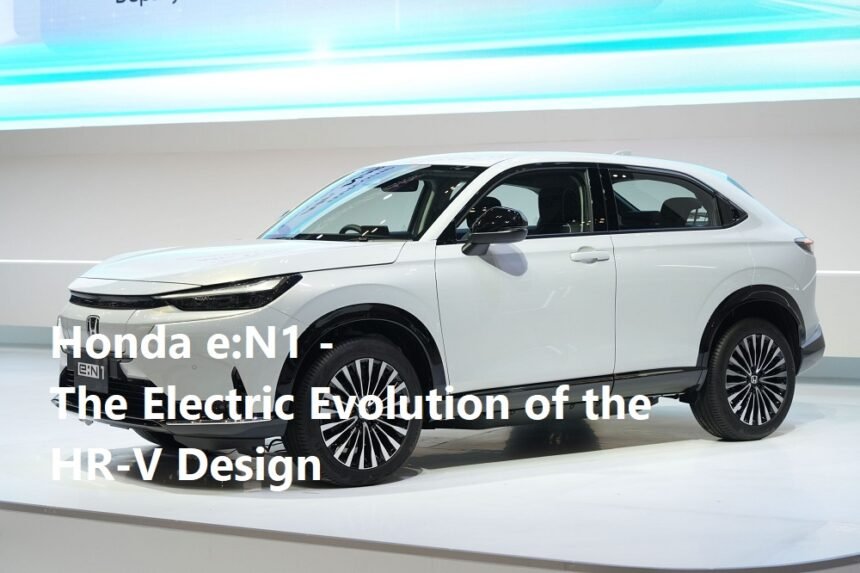Honda’s entry into the electric vehicle (EV) market has been cautious but strategic, and the e:N1 —a compact electric SUV unveiled in 2023—epitomizes this approach. Designed to appeal to fans of Honda’s popular HR-V crossover, the e:N1 adopts a nearly identical silhouette but swaps the combustion engine for a zero-emission powertrain. This blend of familiar aesthetics and cutting-edge EV technology positions the e:N1 as a bridge for loyal Honda drivers transitioning to electric mobility. Here’s why this model could be a game-changer for the brand.
A Design Rooted in Familiarity
At first glance, the e:N1 is almost indistinguishable from the HR-V. Honda intentionally retained the HR-V’s sleek, sporty profile, characterized by:
- Tapered roofline and coupe-like rear.
- Sharp LED headlights connected by a slim light bar.
- Muscular wheel arches and a raised ground clearance for SUV practicality.
However, subtle EV-specific tweaks set it apart:
- Sealed grille with geometric patterns for improved aerodynamics.
- Smoother body panels to reduce drag (drag coefficient: 0.29 Cd).
- Unique alloy wheels designed to enhance efficiency.
By mirroring the HR-V’s design, Honda minimizes the “culture shock” of switching to an EV, making the e:N1 instantly recognizable to its existing customer base.
Built on Honda’s e:N Architecture F
The e:N1 is the first Honda EV to utilize the e:N Architecture F, a front-wheel-drive platform tailored for compact electric vehicles. Key features include:
- High-density battery pack: A 68.8 kWh lithium-ion battery provides a CLTC-rated range of 510 km (~317 miles). While slightly less than rivals like the Nissan Ariya, it’s sufficient for daily urban commutes and weekend trips.
- Efficient powertrain: A single front-mounted motor delivers 201 horsepower and 310 Nm of torque, prioritizing smooth acceleration over sporty performance (0-100 km/h in 7.6 seconds).
- Fast charging: Supports DC fast charging, replenishing the battery from 30% to 80% in 40 minutes.
Honda claims the platform optimizes weight distribution and rigidity, enhancing handling compared to the HR-V.
Interior: A Tech-Focused Upgrade
Inside, the e:N1 diverges from the HR-V with a minimalist, tech-forward cabin:
- 15.1-inch vertical touchscreen: Dominates the dashboard, running Honda’s new e:N OS interface with voice control, 5G connectivity, and over-the-air updates.
- 10.25-inch digital instrument cluster: Customizable displays for driving data and navigation.
- Spacious interior: Despite the sloping roofline, Honda maximizes rear headroom and cargo space (438 liters), matching the HR-V’s practicality.
- Sustainable materials: Recycled fabrics and plant-based resins underscore Honda’s eco-friendly ethos.
Notably, the e:N1 retains physical climate controls—a user-friendly choice compared to touchscreen-reliant competitors.
Honda Sensing 360: Safety Meets Autonomy
The e:N1 debuts Honda’s latest Sensing 360 safety suite, featuring:
- Collision mitigation braking with improved pedestrian detection.
- Adaptive cruise control with lane-centering for highway driving.
- Auto parking assist with 12 ultrasonic sensors.
While not fully autonomous, these features position the e:N1 as a leader in its class for safety innovation.
Market Strategy: Targeting HR-V Loyalists
The e:N1 ’s HR-V-inspired design isn’t accidental. Honda aims to:
- Leverage brand loyalty: HR-V owners looking to go electric can upgrade without sacrificing the design they love.
- Compete in China first: Launched in China (Honda’s largest EV market), the e:N1 faces rivals like the BYD Atto 3 and Tesla Model Y. Pricing starts at ¥209,800 (~$29,000), undercutting many competitors.
- Expand globally: Plans for European and Southeast Asian markets are underway, though U.S. availability remains uncertain.
Challenges Ahead
- Range anxiety: 510 km trails segment leaders (e.g., Hyundai Ioniq 5: 481 km WLTP, but faster charging).
- Brand perception: Honda must convince buyers it’s as serious about EVs as Tesla or BYD.
- Charging infrastructure: Success hinges on regional charging networks, especially in developing markets.
Why the e:N1 Matters
The e:N1 isn’t just Honda’s EV—it’s a symbol of the brand’s evolution. By blending the HR-V’s beloved design with EV innovation, Honda reduces the intimidation factor of going electric. For urban drivers and small families, it offers a pragmatic, stylish entry into zero-emission mobility.
Final Thoughts
The Honda e:N1 proves that electrification doesn’t require reinventing the wheel. By refining a proven design and integrating robust EV tech, Honda creates a compelling option for cautious adopters. While it may not outsell Tesla, the e:N1 ’s greatest achievement could be normalizing EVs for millions of Honda loyalists—one familiar curve at a time.
“The e:N1 is where Honda’s heritage meets its future.” — Honda CEO Toshihiro Mibe
Specs at a Glance:
- Range: 510 km (CLTC)
- Battery: 68.8 kWh
- Charging: 40-minute DC fast charge (30-80%)
- Price: From ~$29,000 (China)
- Availability: China (2023), Europe (2024).
For drivers torn between tradition and innovation, the e:N1 offers the best of both worlds.













